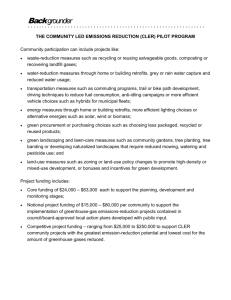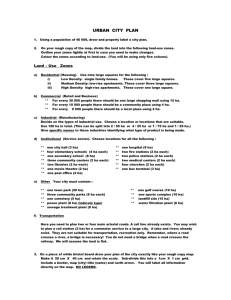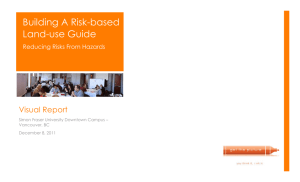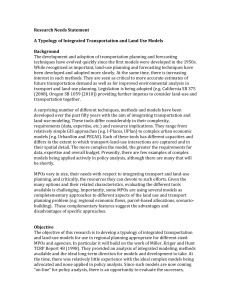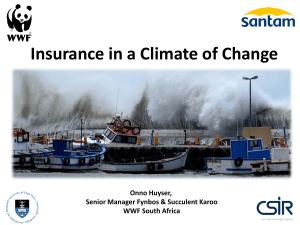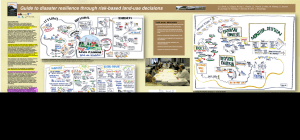Risk-based Land-use Decision Support: A guide for decision makers CRHNet 2010/10/29 Bert Struik
advertisement
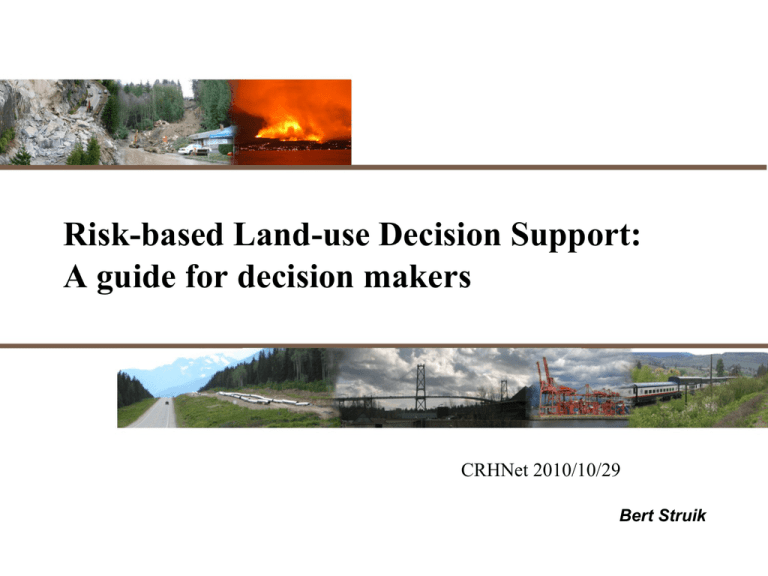
Risk-based Land-use Decision Support: A guide for decision makers CRHNet 2010/10/29 Bert Struik Risk-based land-use evaluation 1. Build a guide for considering land-use options to build disaster resilience 2. Build a tool for learning effective riskbased land-use evaluation 3. Network with mitigators Risk-based land-use evaluation Organizers Bert Struik, NRCan, SFU John Clague, SFU Laurie Pearce, Pearces2 Larry Pearce, Pearces2 Doug Allan, IPREM Cindy Jeromin, PSC Wayne Hirlehey, PSC Murray Day, JIBC Murray Journeay, NRCan Malaika Ulmi, NRCan Fiona Dercole, Dist. N. Vancouver Nicky Hastings, NRCan Jessica Shoubridge, UBC, SCARP WHY, HOW, WHAT Why land-use How we contribute What we contributed so far Creating Resilience instead of Disaster EM-DAT.com Creating Resilience instead of Disaster Influence Land-use decisions Through Best Practice With Existing Instruments Further along spectrum to maximum resilience 2009 Mitigation Workshop 2009 workshop conclusions: Inventory of vulnerability, threat, hazard assessments undertaken (“Evidence-based risk register”) Canadian Mitigation Network (“Mechanisms for sharing knowledge – networks – communication”) Risk prediction system (“Risk knowledge is linked to time”) Mitigation practicality analysis (“Must be cost effective: Benefit – cost ratio”) National Land-use Code (“Land-use and development make codes multi-purpose covering interdependencies”) National Risk Evaluation Network (“shared responsibility”) 2009 Workshop - summary Accountability Mitigation education Communication Decision support (Land-use) Risk system knowledge generation and access Hazard mitigation network Land-use for disaster resilience Create a guide for municipal staff to evaluate and recommend land-use proposals that build disaster resilience Existing Codes and Regulations Land-use acts across Canada that mitigate a hazard Northern Affairs Act Conservation Authorities Act Community Planning Act Risk Reduction Act Water Resources Act Sustainable Development Act Crown Lands Act Municipalities Act Planners Act Lands Act Simulation, Workshop, Network Contributors Simulation and Workshop Attendees and Supporting Agencies 95 participants from 66 agencies Simulation and Workshop Operations 26 volunteers from 9 agencies Organizing Committees 13 organizers from 8 agencies Organizing Committees Bert Struik, NRCan, SFU Murray Journeay, NRCan John Clague, SFU Malaika Ulmi, NRCan Murray Day, JIBC Fiona Dercole, Dist. N. Vancouver Laurie Pearce, Pearces2 Nicky Hastings, NRCan Larry Pearce, Pearces2 Jessica Shoubridge, UBC Cindy Jeromin, PSC Wayne Hirlehey, PSC Simulation Two decision scenarios 1. Proposal to rebuild District of North Vancouver Firehall #3 2. Evaluate development proposals of the Mosquito Creek watershed, District of North Vancouver Done at the JIBC Dr. Donald Rix simulation laboratory on September 13, 2010 Simulation Proposal to rebuild District of North Vancouver Firehall #3 Simulation Proposal to rebuild District of North Vancouver Firehall #3 Simulation Permitting Planners 15 people: Land-use Engineers Burnaby, Mayor Managers Abbotsford, Emergency Geotechnician Nanaimo, Squamish, Vancouver Coastal Health, BC Health Services, Bowen Island, Langley, Consultants in Emergency Management and Geology, and Federal program manager Simulation Operations Built inventory of documentation available to District of North Vancouver Brought in expertise and observers to control room Story board, script and videos to support tabletop scenario setting and operation Simulation Operations Plenary review of the pod experience Interactive Evaluation Land-use Decision Support: Simulation Reducing the Risk from Hazards JIBC, 2010/09/13 Simulation - Learning Tell me what's important Safe for intended use Need the definition Need National, Provincial and Local Standards and Guides Need a Development Permit Area guideline. Need a Community defined “Risk Tolerance Criteria” Define risk Simulation - Learning Your job is planner is emergency manager is engineer is permits officer is geo-engineer .... We get to the same place differently House in way of flow or flow in way of house or were there people in the house? Define the problem First reaction was to ensure they and city weren't liable Rather than define responsibilities Liability Safety Risk-based land-use decision simulation: Opportunities Excellent professional development opportunity Community centric Smaller communities Simpler documentation Sharing best practices through doing Workshop Knowledge Defining Risk Governance Making Decisions Breakouts Knowledge Defining Risk Governance Making Decisions Breakout #3 Guide part 1- tools • • • • • • • • • • Address Liability issue Legislation guide Case studies set Roles and responsibility Lexicon Risk tolerance criteria Level of safety HRVA Hazard assessment Risk assessment • • • • • DPAs Communication / education system Regulations Checklist Consultant terms of reference Guide part 2: Recieve proposal • • • • • • • • • Confirm complete application Tracking list Review based on bylaws Land-use review In OCP or DPA? Referral collation Report back context to developer Internal / external referral Liens check • • • • Imact on response plans Review by stakeholders Prepare common language summary Complete analysis and refer to developer for desire to proceed Guide part 3: Evaluation • • • • • • • • Engineering standards? • • Apply OCP Check zoning Do HVRA Educate public on hazards Consider mitigation alternatives Run by experts Evaluate impacts and risks Public input Make recommendation Guide part 4: Monitor • • • • • • • Re-evaluate Hazard and Risk Risk assessment for existing structures Establish liabilities Cost-benefit analysis Review operations Process to rationalize previous land-use decisions Monitor against tolerance criteria • • • • • • • • Review DPAs and OCPs Review decision criteria Continuous review? Legislative changes for risk-based plan / decision -reward system New reports On time and budget Verify process Agency exchange Follow up Draft results from this workshop and last Monday's risk-based planning land-use simulation presented for commentary and input at: Canadian Risk and Hazards Network (CRHNet) Annual Symposium in Fredericton, New Brunswick, October 27 - 29, 2010 Emergency Preparedness Conference in Vancouver, BC, November 22 - 24, 2010. Draft guide written and distributed to you for several iterations of review Guide published.

